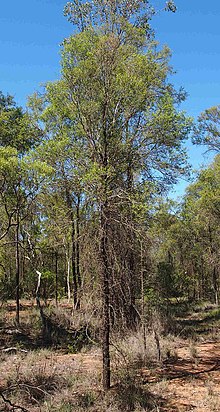Flindersia dissosperma
Flindersia dissosperma, commonly known as scrub leopardwood,[2] is a species of small tree in the family Rutaceae and is endemic to eastern-central Queensland. It usually has pinnate leaves with between three and five elliptical to egg-shaped leaves, panicles of white to cream-coloured flowers and fruit studded with rough points.
| Broad-leaved leopard tree | |
|---|---|
 | |
| Habit near Bauhinia | |
| Scientific classification | |
| Kingdom: | Plantae |
| Clade: | Tracheophytes |
| Clade: | Angiosperms |
| Clade: | Eudicots |
| Clade: | Rosids |
| Order: | Sapindales |
| Family: | Rutaceae |
| Genus: | Flindersia |
| Species: | F. dissosperma |
| Binomial name | |
| Flindersia dissosperma | |
| Synonyms[1] | |
| |

Description
Flindersia dissosperma is a tree that typically grows to a height of 10 m (33 ft). The leaves are arranged in opposite pairs, 15–630 mm (0.59–24.80 in) long, and are usually pinnate with between three and five elliptical to egg-shaped leaflets with the narrower end towards the base. The leaflets are 6–37 mm (0.24–1.46 in) long, 2–8 mm (0.079–0.315 in) wide, the rachis of the leaf winged and the leaflets sessile. The flowers are arranged in panicles 20–90 mm (0.79–3.54 in) long and there are usually at least a few male-only flowers. The sepals are 1–1.5 mm (0.039–0.059 in) long and the petals white to cream-coloured and 3–3.5 mm (0.12–0.14 in) long. Flowering occurs from August to October and the fruit is a woody capsule 20–30 mm (0.79–1.18 in) long containing winged seeds 15–18 mm (0.59–0.71 in) long.[2][3]
Taxonomy
Scrub leopardwood was first formally described in 1857 by Ferdinand von Mueller who published the description in Hooker's Journal of Botany and Kew Garden Miscellany and gave the plant the name Strzeleckya dissosperma.[4][5] In 1929, Karel Domin changed the name to Flindersia dissosperma in Bibliotheca Botanica.[6]
Distribution and habitat
Scrub leopardwood mainly grows in dry scrub, often with brigalow (Acacia harpophylla) and poplar box (Eucalyptus populnea). It is found in east-central Queensland from near Charters Towers to near Springsure.[2]
Conservation status
Flindersia dissosperma is classified as of "least concern" under the Queensland Government Nature Conservation Act 1992.[7]
References
- "Flindersia dissosperma". Australian Plant Census. Retrieved 17 July 2020.
- Hartley, Thomas G.; Wilson, Annette J.G. (ed.) (2013). Flora of Australia (Volume 26). Canberra: Australian Biological Resources Study. p. 70. Retrieved 17 July 2020.CS1 maint: extra text: authors list (link)
- Hartley, Thomas Gordon (1969). "A revision of the genus Flindersia (Rutaceae)". Journal of the Arnold Arboretum. 50 (4): 514–516. Retrieved 17 July 2020.
- "Strzeleckya dissosperma". APNI. Retrieved 17 July 2020.
- von Mueller, Ferdinand; Hooker, William Jackson (ed.) (1857). "New genera discovered during the North Australian Exploring Expedition". Hooker's Journal of Botany and Kew Garden Miscellany. 9: 308–309. Retrieved 17 July 2020.CS1 maint: extra text: authors list (link)
- "Flindersia dissosperma". APNI. Retrieved 17 July 2020.
- "Species profile—Flindersia dissosperma". Queensland Government Department of Environment and Science. Retrieved 17 July 2020.